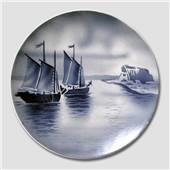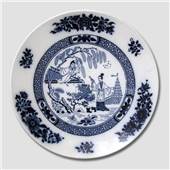
In Septfontaines (Seven Springs) not far from the fortress of Luxembourg, the company "Jean-Francois Boch et frères" was initiated. The company produced an early serial production in 1767. By 1770 they introduced a dinner-set with the so called "Brindille" pattern. The dinner set is still in production, now under the name "Alt Luxemburg". Pierre-Joseph (1737-1818) progressed in developing the pottery production together with his brothers. Production is still active in Septfontaines today. Next to the production plant the brothers built a castle "Chateau Septfontaines" used as the family's private residence.




The businessman Nicolas Villeroy started an earthenware production in the village of Vaudrevange (today called Wallerfangen) by the Saar River. Successfully he produced printed tableware by means of copper-plating. Reducing costs to a minimum - a decisive pre-condition in cost-effective serial production.
By the Saar River in Mettlach, Jean-Francois Boch purchased the old Benedictine Convent in 1809. He converted the old baroque buildings into a top-tuned highly modern, production plant for tableware - primary to be used for mechanic production. He personally built several of the production-machines. His inventions advanced the transition from manual to industrial production considerably. The former convent is today the Villeroy and Boch headquarters.
In 1812 Pierre-Joseph Boch founded the "Antonius Guild" in Septfontaines. A social system for workers, the benefits far exceeding those introduced in the Bismarck social security, launched some 70 years later.
A new type of earthenware, extremely hard and bright white, was developed by Boch in 1829. The quality is so much like porcelain, that it was called porcelain stoneware. No other manufacturers were capable of producing anything similar.
The competitors Jean-Francois Boch and Nicolas Villeroy merged in 1836, in order to survive on the European market. In total they had three production plants at their disposal. "Villeroy & Boch" was born, and together they commenced the rise to the top of the porcelain trade.
The company expanded in 1843, buying the glass works "The Cristallerie" in Wadgassen. A new type of tile-production was developed in 1846 in Septfontaines. A dry compression moulding technique, that is still used today. By then Villeroy and Boch supplied tableware to France, Poland, Switzerland and England as well as all of Germany. The cultivation of foreign markets was intensified. The production of bone china and the marble-like parian commence, at the same time as multi-coloured pattern printing was introduced.
Writing 1850, Villeroy & Boch goods were exported to all of Europe, as well as to North and South America. Only two years later production of a newly developed floor-tile set out. The beautiful looks and the hard-wearing qualities so attractive, that the demand forced Villeroy and Boch to open a new factory in Mettlach.
The first factory in Europe only manufacturing tiles opened in 1852. The newly developed tiles were called "The Mettlacher Tile" (Mettlacher platten).
Villeroy & Boch bought the factory "Merzig" by the Saar River in 1879, as the company was again in great need of expansion. The Merzig factory developed into the world's biggest production plant of tiles. Another production line manufacturing terracotta tiles was commenced, bringing global success. The tiles were called architectural ceramics.
In those days another speciality at Villeroy and Boch's, was the production of washing vessels. Washing vessels being a need to all people, regardless of circumstances, V&B had a good business going. From 1822 and onwards this production decreased in favour of the production of ceramic sanitary ware, as we know them today.
By 1899 an extensive production of bathtubs, sinks and toilets begun in Merzig, using the new pipe-clay material. Hygiene makes its entrance. Villeroy and Boch was doing really well around the turn of the century.
Following World War 1, when The Saar was split-up from Germany, the factories could no longer deliver their articles to the German market. Because of that Villeroy & Boch opened factories in Bonn and Breslau. The creative ideas of The Bauhaus School exerted big influence on the development of the Villeroy & Boch factories in the 1930'ies. The ideas of the school influenced all of the company's products.
During World War 2 factories in Germany were damaged considerably. After the war, Dresden, Breslau and Torgau were under foreign administration and the factories in The Saar were integrated in the French zone. Villeroy & Boch hit rock bottom before the rise to global consortium. The production of the new, extremely hard, vitreous porcelain started in 1959 in Septfontaines.
The Japanese interest in European porcelain started in 1971, resulting in comprehensive shipments to Japan. The popularity of Villeroy & Boch rose in the overseas markets as well, in the American particularly. The meaning of good artists became more and more important. The whole trade was shaken, when Luigi Colani (German designer, born Lutz Colani in Berlin, 1928) was commissioned to design a complete bathroom-interior-system. To V&B it meant a totally new way of thinking. From having produced only separate articles, they started producing total living-areas (total-interiors).
The "Heinrich" porcelain factory in Selb became part of the group in 1976.
By 1987 Villeroy & Boch were converted into a public limited, the Capital remaining family property. Paloma Picasso commenced her co-operation with Villeroy & Boch, by designing tiles, followed by tableware, cutlery and crystal collections.
During a re-construction in 1982, the enterprise was split into three divisions: Tiles, sanitary ware and tableware/crystal:
Villeroy & Boch Ceramics, producing tableware including porcelain, crystal and cutlery,
Villeroy & Boch producing sanitary ware and bathroom interior such as furniture etc. and finally
Villeroy and Boch Tiles producing the charismatic flags and tiles for walls as well as floors.
The Sanitary Division instantly starts expanding. Acquiring a 50% stake in the Dutch company Ucosan in 1989 is only the beginning. In developing the producing of bathroom furniture, half the shares in the Austrian "db Das Bad2"was purchased in 1991. The majority interest in the Hungarian Alfóldi Porcelángyár is bought in 1992 - the company being the biggest manufacturer of ceramic sanitary ware in Hungary and the second biggest in the tile production. In 1996 the majority interest in the Rumanian Mondial S. A., also manufacturers of tiles and sanitary ware. The following year the Italian Ceramica Ligure S.r.L. - specialists in stone-tiles, were incorporated in the group. The remaining 50 % of the shares in Ucosan were taken over in 1999. At a merger in 2000 the Swedish Gustavsberg was taken over, followed by the take-over of several other manufacturers of bathroom interior.
The Villeroy & Boch headquarters is situated in Mettlach in The Saar. The castle in Mettlach was purchased by Jean-Francois Boch (1782-1858) for production purposes. The production plant is still active. Also at the factory in Mettlach, you will find the Villeroy & Boch "Tableware Discovery Center" - a ceramic museum/showroom, exhibiting the consortium production during 250 years. One of several rarities exhibited here, are tiles exactly like the ones that V&B supplied to the most famous ship of the world-history - "Titanic". The museum is a popular destination for tourists. Across the river Saar in Mettlach, Villeroy & Boch owns yet another castle "Saareck Castle"
Today The Villeroy & Boch Group is run by Wendelin von Boch, 8. generation of the founder-family. More than 30 million units is produced every year in the tableware division, and the turnover surpassed 1 billion Euro.
The castles Chateau Septfontianes and Saareck Castle are today used for guest accommodation, and reserved exclusively for invited guests. The public has no admission. Former prime minister Margaret Thatcher and the German chancellor Helmut Kohl among others have spend the night in one of the castles.
The company has always been very customer-minded. Villeroy & Boch today reflects the innovation and the speed of a highly modern group. The company has the will, the means and the talent to change, to innovate, to close down, to take over whenever it is needed, giving it a highly competitive lead in the world market. In the tableware-division today, production is separated into four different lifestyle-designs, developed on behalf of V&B, by various designers and trend-spotters. The lifestyle-designs each express their personal attitude to life, which should be reflected in the signals of the design.
The designs are:
- Classic Collection (Classic, elegant design)
- Country Collection (decorative, emotional design)
- Metropolitan Collection (sophisticated new-puritan big-city design)
- Easy Collection (uncomplicated design for the quite young)


 We are e-approved
We are e-approved





